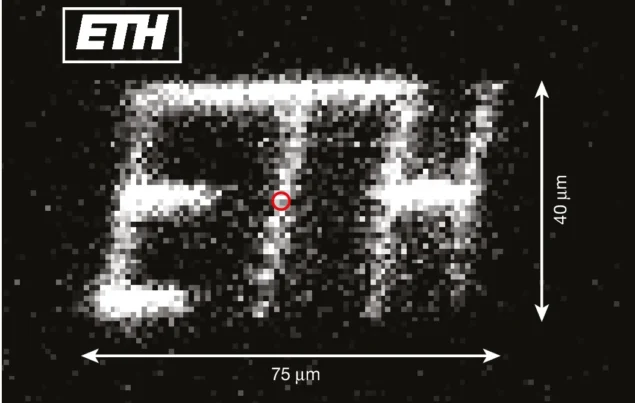New ion-trapping approach could help quantum computers scale up
25 Mar 2024
Ions on the move: To create this image, the ETH Zürich researchers repeatedly transported a single trapped ion from its initial position (red circle) to 58 other positions, imaged it in its new location, and returned it to its starting point. They repeated this sequence 172 times. (Courtesy: Jain, S, Sägesser, T, Hrmo, P et al., Penning micro-trap for quantum computing. Nature 627, 510–514 (2024). https://doi.org/10.1038/s41586-024-07111-x)
Trapping ions with static magnetic and electric fields instead of an oscillating electromagnetic field could make it easier to use ions as building blocks for quantum computers. The new approach, which was developed by researchers at ETH Zurich in Switzerland, allows better control of an ion’s quantum state and position, and marks an important step towards scaling up trapped ions as a platform for quantum computation.
Quantum computers can outperform classical ones at certain problems. Realizing their full potential will, however, require machines that can manipulate around 1 million quantum bits (qubits). This is orders of magnitude more than today’s largest quantum processors, and scaling up is challenging because qubits become more difficult to produce and control as their numbers increase.
For example, the ions used as qubits in trapped-ion quantum processors are usually kept in place by electromagnetic fields oscillating at radio frequencies (RF), and their quantum states are controlled and read with pulses of laser light. This works well for up to 30 qubits, but scaling to higher numbers is tricky. Combining RF fields in the small space of a single chip is challenging, and the fields also heat the trap, disturbing the ions’ quantum behaviour. A further problem is that the structure of the RF fields restricts trap locations to a linear grid.
Penning traps
The ETH team addressed these problems by switching to a type of trap that is traditionally used to confine ions for applications such as precision spectroscopy and quantum simulations. These so-called Penning traps replace RF fields with strong static magnetic fields, which eliminates heating and removes restrictions on trap configuration. However, strong magnetic fields bring their own challenges. Their presence increases the spacing between the ions’ energy states, making it harder to control these states with light from simple, cheap diode lasers. The superconducting magnets that produce them are also bulky, and laser light needs to be guided around them.
To overcome these challenges, the ETH researchers constructed their Penning trap by placing a microfabricated chip (produced by colleagues at Leibniz University in Hannover, Germany) with several electrodes inside a 3 Tesla superconducting magnet. A system of mirrors guides phase-locked laser beams through the magnet to the ions, and the entire set-up is placed in a vacuum and cryogenically cooled.
It’s a trap!
The new trap lived up to expectations, confining a single ion for several days and giving the ETH researchers full control over its movement and position (see image). To test the set-up’s viability for quantum computing, the team measured the ion’s coherence time – that is, the amount of time it remains in a quantum state – and showed that this was longer than the time required to perform a quantum operation. They also showed that lasers could control the energy states of the ion without disturbing its quantum superposition. This capability makes it possible to create entangled states between different qubits and therefore perform quantum computations.READ MORE

Peter Zoller, a physicist at the University of Innsbruck, Austria, who was not involved in this project, describes the micro-Penning trap with easy ion transport as a “refreshing, innovative idea”. He adds that it is great to see innovations used for trapped arrays of neutral atoms being applied to trapped ion architectures. However, he points out that the trap’s capabilities have so far only been shown for a single ion. It will be interesting, he says, to see how it scales and performs (in the form of gate fidelities) with many ions, and how it compares with alternative approaches such as surface traps or quantum racetracks.
Jonathan Home, the leader of the ETH team, agrees that adding more ions is important. The next steps, he tells Physics World, will be to “try to load multiple ions and perform multi-qubit gates between ions in separate trap sites”.
The research is published in Nature.
Martijn Boerkamp is a science writer based in the Netherlands.
FROM PHYSICSWORLD.COM 27/3/2024

Δεν υπάρχουν σχόλια:
Δημοσίευση σχολίου